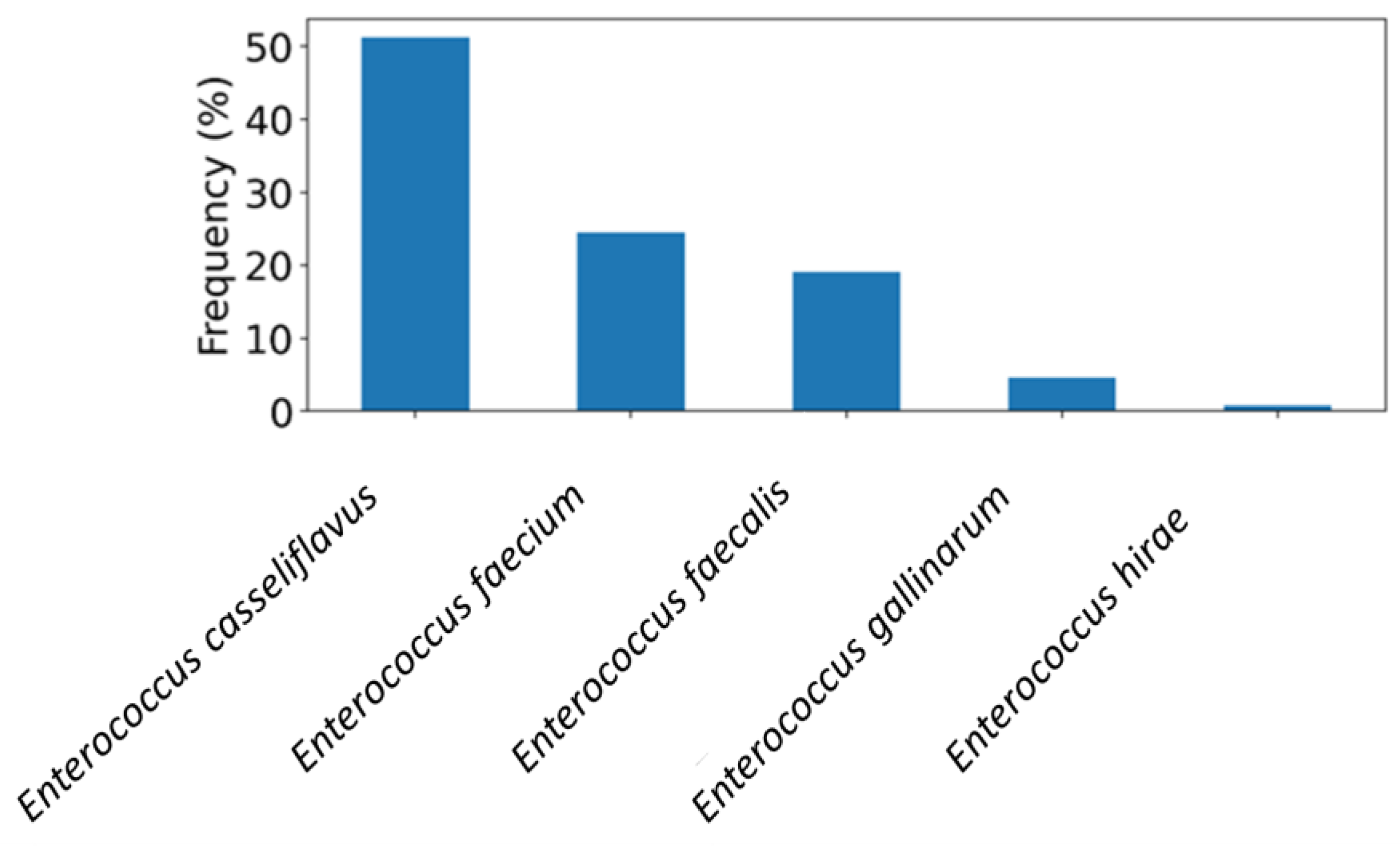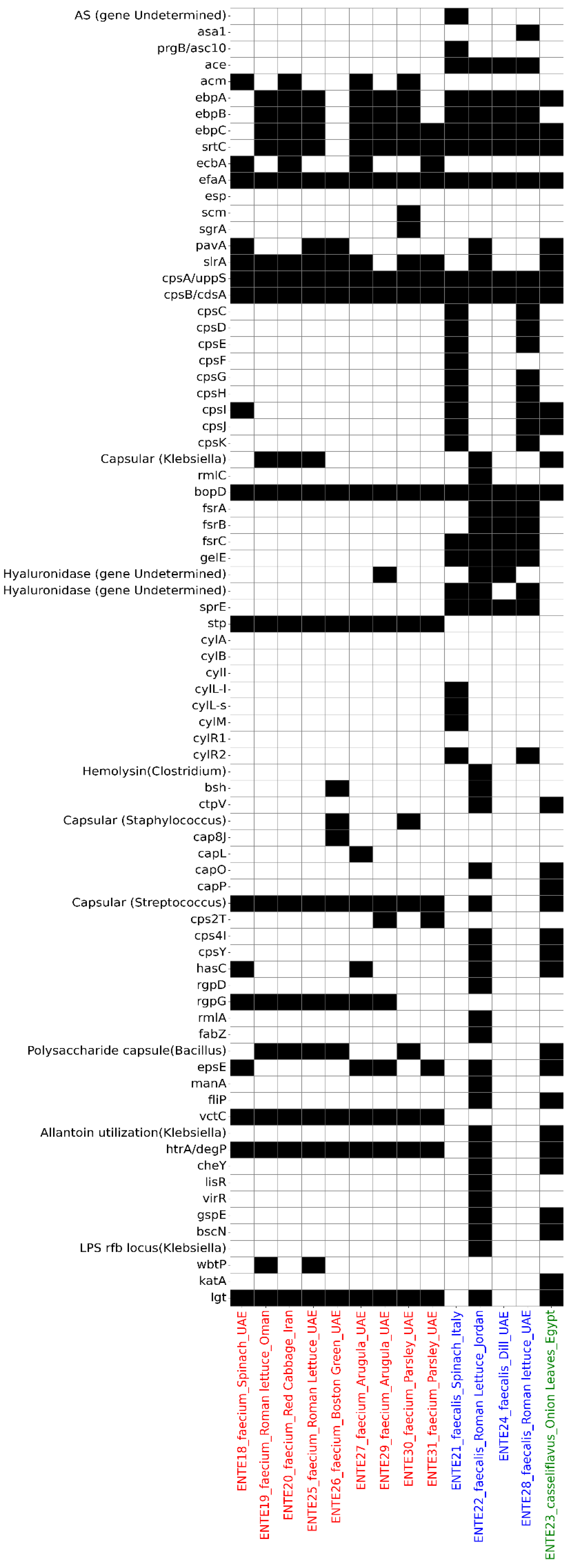Salad Vegetables as a Reservoir of Antimicrobial-Resistant Enterococcus: Exploring Diversity, Resistome, Virulence, and Plasmid Dynamics
Abstract
1. Introduction
2. Materials and Methods
2.1. Sources and Sample Selection
2.2. Enterococcus Isolation and Characterization
2.3. Evaluation of Phenotypic AMR
2.4. Whole-Genome Sequencing
2.5. Plasmid Mobility Evaluation
3. Results
3.1. Diversity of Enterococcus Species
3.2. Antimicrobial Susceptibility Profiles Across Enterococcus Species
3.3. Whole-Genome Analysis: Resistome Composition
3.4. Whole-Genome Analysis: Virulome Composition
3.5. Plasmid Architecture of Enterococcus Isolates
4. Discussion
5. Conclusions
Author Contributions
Funding
Institutional Review Board Statement
Informed Consent Statement
Data Availability Statement
Acknowledgments
Conflicts of Interest
References
- Habib, I.; Khan, M.; Mohamed, M.I.; Ghazawi, A.; Abdalla, A.; Lakshmi, G.; Elbediwi, M.; Al Marzooqi, H.M.; Afifi, H.S.; Shehata, M.G.; et al. Assessing the Prevalence and Potential Risks of Salmonella Infection Associated with Fresh Salad Vegetable Consumption in the United Arab Emirates. Foods 2023, 12, 3060. [Google Scholar] [CrossRef] [PubMed]
- Wang, Y.; Xu, W.; Guo, S.; Xu, S.; Wang, J.; Zhang, S.; Kuang, Y.; Jin, P. Enterococci for Human Health: A Friend or Foe? Microb. Pathog. 2025, 201, 107381. [Google Scholar] [CrossRef] [PubMed]
- Almeida-Santos, A.C.; Novais, C.; Peixe, L.; Freitas, A.R. Vancomycin-Resistant Enterococcus faecium: A Current Perspective on Resilience, Adaptation, and the Urgent Need for Novel Strategies. J. Glob. Antimicrob. Resist. 2025, 41, 233–252. [Google Scholar] [CrossRef]
- Abd El-Hamid, M.I.; Abd El-Aziz, N.K.; Ammar, A.M.; Gharib, A.A.; Ibrahim, G.A.; Moawed, B.F.M.; Alshamy, H.; El-Malt, R.M.S. Emergence of Multi-Drug-Resistant, Vancomycin-Resistant, and Multi-Virulent Enterococcus Species from Chicken, Dairy, and Human Samples in Egypt. J. Appl. Microbiol. 2025, 136, lxaf001. [Google Scholar] [CrossRef]
- Torres, C.; Alonso, C.A.; Ruiz-Ripa, L.; León-Sampedro, R.; Del Campo, R.; Coque, T.M. Antimicrobial Resistance in Enterococcus spp. of Animal Origin. Microbiol. Spectr. 2018, 6, 41. [Google Scholar] [CrossRef]
- Kuroda, M.; Sekizuka, T.; Matsui, H.; Suzuki, K.; Seki, H.; Saito, M.; Hanaki, H. Complete Genome Sequence and Characterization of Linezolid-Resistant Enterococcus faecalis Clinical Isolate KUB3006 Carrying a cfr(B)-Transposon on its Chromosome and optrA-Plasmid. Front. Microbiol. 2018, 9, 2576. [Google Scholar] [CrossRef]
- da Costa, P.M.; Loureiro, L.; Matos, A.J. Transfer of Multidrug-Resistant Bacteria between Intermingled Ecological Niches: The Interface between Humans, Animals and the Environment. Int. J. Environ. Res. Public Health 2013, 10, 278–294. [Google Scholar] [CrossRef]
- Kim, M.C.; Cha, M.H.; Ryu, J.G.; Woo, G.J. Characterization of Vancomycin-Resistant Enterococcus faecalis and Enterococcus faecium Isolated from Fresh Produces and Human Fecal Samples. Foodborne Pathog. Dis. 2017, 14, 195–201. [Google Scholar] [CrossRef]
- Wang, Z.; Cao, Q.; Liu, Q.; Dufe, D.; Wouters, P.; Deng, L.; Pong, A. How Many Subjects Are Enough in a Veterinary Trial?—Literature Review and Insights from Industrial Statisticians. Res. Vet. Sci. 2025, 186, 105569. [Google Scholar] [CrossRef]
- Habib, I.; Ghazawi, A.; Lakshmi, G.B.; Mohamed, M.I.; Li, D.; Khan, M.; Sahibzada, S. Emergence and Genomic Characterization of the First Reported optrA-Carrying Linezolid-Resistant Enterococci Isolated from Retail Broiler Meat in the United Arab Emirates. Foods 2022, 11, 3190. [Google Scholar] [CrossRef]
- CLSI. Performance Standards for Antimicrobial Susceptibility Testing, 33rd ed.; CLSI Supplement M100; Clinical and Laboratory Standards Institute: Wayne, PA, USA, 2023. [Google Scholar]
- Magiorakos, A.-P.; Srinivasan, A.; Carey, R.B.; Carmeli, Y.; Falagas, M.E.; Giske, C.G.; Harbarth, S.; Hindler, J.F.; Kahlmeter, G.; Olsson-Liljequist, B.; et al. Multidrug-Resistant, Extensively Drug-Resistant and Pandrug-Resistant Bacteria: An International Expert Proposal for Interim Standard Definitions for Acquired Resistance. Clin. Microbiol. Infect. 2012, 18, 268–281. [Google Scholar] [CrossRef] [PubMed]
- Saratto, T.; Visuri, K.; Lehtinen, J.; Ortega-Sanz, I.; Steenwyk, J.L.; Sihvonen, S. Solu: A Cloud Platform for Real-Time Genomic Pathogen Surveillance. BMC Bioinform. 2025, 26, 12. [Google Scholar] [CrossRef]
- Roberts, L.W.; Forde, B.M.; Hurst, T.; Ling, W.; Nimmo, G.R.; Bergh, H.; George, N.; Hajkowicz, K.; McNamara, J.F.; Lipman, J.; et al. Genomic Surveillance, Characterization and Intervention of a Polymicrobial Multidrug-Resistant Outbreak in Critical Care. Microb. Genom. 2021, 7, mgen000530. [Google Scholar] [CrossRef]
- Robertson, J.; Nash, J.H.E. MOB-Suite: Software Tools for Clustering, Reconstruction and Typing of Plasmids from Draft Assemblies. Microb. Genom. 2018, 4, e000206. [Google Scholar] [CrossRef] [PubMed]
- Garcillán-Barcia, M.P.; Francia, M.V.; de la Cruz, F. The Diversity of Conjugative Relaxases and Its Application in Plasmid Classification. FEMS Microbiol. Rev. 2009, 33, 657–687. [Google Scholar] [CrossRef]
- Habib, I.; Lakshmi, G.B.; Mohamed, M.I.; Ghazawi, A.; Khan, M.; Li, D. Enumeration, Antimicrobial Resistance, and Virulence Genes Screening of Enterococcus spp. Isolated from Retail Chicken Carcasses in the United Arab Emirates. Foodborne Pathog. Dis. 2022, 19, 590–597. [Google Scholar] [CrossRef] [PubMed]
- Al-Kharousi, Z.S.; Guizani, N.; Al-Sadi, A.M.; Al-Bulushi, I.M. Antimicrobial Susceptibility of Fresh Produce-Associated Enterobacteriaceae and Enterococci in Oman. Foods 2021, 11, 3085. [Google Scholar] [CrossRef]
- Tango, C.N.; Wei, S.; Khan, I.; Hussain, M.S.; Kounkeu, P.N.; Park, J.H.; Kim, S.H.; Oh, D.H. Microbiological Quality and Safety of Fresh Fruits and Vegetables at Retail Levels in Korea. J. Food Sci. 2018, 83, 386–392. [Google Scholar] [CrossRef]
- Chajęcka-Wierzchowska, W.; Zarzecka, U.; Zadernowska, A. Enterococci Isolated from Plant-Derived Food—Analysis of Antibiotic Resistance and the Occurrence of Resistance Genes. LWT 2021, 139, 110549. [Google Scholar] [CrossRef]
- Mullally, C.A.; Fahriani, M.; Mowlaboccus, S.; Coombs, G.W. Non-faecium Non-faecalis Enterococci: A Review of Clinical Manifestations, Virulence Factors, and Antimicrobial Resistance. Clin. Microbiol. Rev. 2024, 37, e0012123. [Google Scholar] [CrossRef]
- Ben Said, L.; Klibi, N.; Dziri, R.; Borgo, F.; Boudabous, A.; Ben Slama, K.; Torres, C. Prevalence, Antimicrobial Resistance and Genetic Lineages of Enterococcus spp. from Vegetable Food, Soil and Irrigation Water in Farm Environments in Tunisia. J. Sci. Food Agric. 2016, 96, 1627–1633. [Google Scholar] [CrossRef] [PubMed]
- Arias, C.A.; Courvalin, P.; Reynolds, P.E. vanC Cluster of Vancomycin-Resistant Enterococcus gallinarum BM4174. Antimicrob. Agents Chemother. 2000, 44, 1660–1666. [Google Scholar] [CrossRef]
- Schwaiger, K.; Bauer, J.; Hörmansdorfer, S.; Mölle, G.; Preikschat, P.; Kämpf, P.; Bauer-Unkauf, I.; Bischoff, M.; Hölzel, C. Presence of the Resistance Genes vanC1 and pbp5 in Phenotypically Vancomycin- and Ampicillin-Susceptible Enterococcus faecalis. Microb. Drug Resist. 2012, 18, 434–439. [Google Scholar] [CrossRef]
- Hölzel, C.; Bauer, J.; Stegherr, E.M.; Schwaiger, K. Presence of the Vancomycin Resistance Gene Cluster vanC1, vanXYc, and vanT in Enterococcus casseliflavus. Microb. Drug Resist. 2014, 20, 177–180. [Google Scholar] [CrossRef] [PubMed]
- Pesavento, G.; Calonico, C.; Ducci, B.; Magnanini, A.; Lo Nostro, A. Prevalence and Antibiotic Resistance of Enterococcus spp. Isolated from Retail Cheese, Ready-to-Eat Salads, Ham, and Raw Meat. Food Microbiol. 2014, 41, 1–7. [Google Scholar] [CrossRef]
- Johnston, L.M.; Jaykus, L.A. Antimicrobial Resistance of Enterococcus Species Isolated from Produce. Appl. Environ. Microbiol. 2004, 70, 3133–3137. [Google Scholar] [CrossRef]
- Werner, G.; Hildebrandt, B.; Witte, W. The Newly Described msrC Gene Is Not Equally Distributed among All Isolates of Enterococcus faecium. Antimicrob. Agents Chemother. 2001, 45, 3672–3673. [Google Scholar] [CrossRef] [PubMed][Green Version]
- Chen, Y.H.; Lin, S.Y.; Lin, Y.T.; Tseng, S.P.; Chang, C.C.; Yu, S.Y.; Hung, W.W.; Jao, Y.T.; Lin, C.Y.; Chen, Y.H.; et al. Emergence of aac(6′)-Ie-aph(2″)-Ia-Positive Enterococci with Non-High-Level Gentamicin Resistance Mediated by IS1216V: Adaptation to Decreased Aminoglycoside Usage in Taiwan. J. Antimicrob. Chemother. 2021, 76, 1689–1697. [Google Scholar] [CrossRef]
- Messele, Y.E.; Trott, D.J.; Hasoon, M.F.; Veltman, T.; McMeniman, J.P.; Kidd, S.P.; Petrovski, K.R.; Low, W.Y. Phylogeny, Virulence, and Antimicrobial Resistance Gene Profiles of Enterococcus faecium Isolated from Australian Feedlot Cattle and Their Significance to Public and Environmental Health. Antibiotics 2023, 12, 1122. [Google Scholar] [CrossRef]
- Shridhar, P.B.; Amachawadi, R.G.; Tokach, M.; Patel, I.; Gangiredla, J.; Mammel, M.; Nagaraja, T.G. Whole Genome Sequence Analyses-Based Assessment of Virulence Potential and Antimicrobial Susceptibilities and Resistance of Enterococcus faecium Strains Isolated from Commercial Swine and Cattle Probiotic Products. J. Anim. Sci. 2022, 100, skac030. [Google Scholar] [CrossRef]
- El Zowalaty, M.E.; Lamichhane, B.; Falgenhauer, L.; Mowlaboccus, S.; Zishiri, O.T.; Forsythe, S.; Helmy, Y.A. Antimicrobial Resistance and Whole Genome Sequencing of Novel Sequence Types of Enterococcus faecalis, Enterococcus faecium, and Enterococcus durans Isolated from Livestock. Sci. Rep. 2023, 13, 18609. [Google Scholar] [CrossRef]




| Species | Isolates | Source | No. of Plasmids | Size (bp) | MOB Cluster | Resistance Genes Harbored on Plasmid | Replicon Types | Mobility |
|---|---|---|---|---|---|---|---|---|
| Enterococcus faecium | ENT-31 | Parsley UAE | 1 | 26,145 | AB756 | tet(L), tet(M) | rep_cluster_1018, rep_cluster_185 | mobilizable |
| ENT-30 | Parsley UAE | 3 | 52,765 | AC731 | None | rep_cluster_893 | non-mobilizable | |
| 27,735 | AB756 | ant(6)-Ia, lnu(B), lsa(E), spw, tet(L), tet(M) | rep_cluster_185 | mobilizable | ||||
| 5972 | AA894 | None | rep_cluster_1742 | mobilizable | ||||
| ENT-29 | Arugula, UAE | 2 | 133,159 | AD908 | None | rep_cluster_893 | conjugative | |
| 44,140 | AB756 | ant(6)-Ia, aph(3′)-IIIa, erm(B), sat4, tet(L), tet(M) | rep_cluster_1018, rep_cluster_185 | mobilizable | ||||
| ENT-27 | Arugula, UAE | 2 | 116,750 | AC727 | None | Inc18, rep_cluster_893 | non-mobilizable | |
| 19,166 | AB756 | tet(L), tet(M) | rep_cluster_1018, rep_cluster_185 | mobilizable | ||||
| ENT-26 | Boston Green Lettuce, UAE | 3 | 81,412 | AC727 | None | rep_cluster_893 | non-mobilizable | |
| 30,390 | AD582 | tet(L), tet(M) | mobilizable | |||||
| 18,377 | AB918 | ant(6)-Ia, lnu(B), lsa(E), spw | non-mobilizable | |||||
| ENT-25 | Roman Lettuce, UAE | 4 | 48,220 | AD582 | tet(L), tet(M) | mobilizable | ||
| 40,528 | AD907 | None | rep_cluster_893 | conjugative | ||||
| 10,144 | AB915 | erm(B) | non-mobilizable | |||||
| 51,220 | AC728 | None | mobilizable | |||||
| Enterococcus faecalis | ENT-28 | Roman Lettuce, UAE | 1 | 3845 | AD569 | None | rep_cluster_1197 | non-mobilizable |
| ENT-22 | Roman Lettuce, Jordan | 2 | 65,530 | AD582 | catA, dfrG, tet(L), tet(M) | rep_cluster_1118, rep_cluster_992 | mobilizable | |
| 6362 | AD265 | None | non-mobilizable | |||||
| ENT-21 | Spinach, Italy | 1 | 5982 | AD058 | catA, erm(B) | rep_cluster_1118 | non-mobilizable |
Disclaimer/Publisher’s Note: The statements, opinions and data contained in all publications are solely those of the individual author(s) and contributor(s) and not of MDPI and/or the editor(s). MDPI and/or the editor(s) disclaim responsibility for any injury to people or property resulting from any ideas, methods, instructions or products referred to in the content. |
© 2025 by the authors. Licensee MDPI, Basel, Switzerland. This article is an open access article distributed under the terms and conditions of the Creative Commons Attribution (CC BY) license (https://creativecommons.org/licenses/by/4.0/).
Share and Cite
Habib, I.; Khan, M.; Lakshmi, G.B.; Mohamed, M.-Y.I.; Ghazawi, A.; Al-Rifai, R.H. Salad Vegetables as a Reservoir of Antimicrobial-Resistant Enterococcus: Exploring Diversity, Resistome, Virulence, and Plasmid Dynamics. Foods 2025, 14, 1150. https://doi.org/10.3390/foods14071150
Habib I, Khan M, Lakshmi GB, Mohamed M-YI, Ghazawi A, Al-Rifai RH. Salad Vegetables as a Reservoir of Antimicrobial-Resistant Enterococcus: Exploring Diversity, Resistome, Virulence, and Plasmid Dynamics. Foods. 2025; 14(7):1150. https://doi.org/10.3390/foods14071150
Chicago/Turabian StyleHabib, Ihab, Mushtaq Khan, Glindya Bhagya Lakshmi, Mohamed-Yousif Ibrahim Mohamed, Akela Ghazawi, and Rami H. Al-Rifai. 2025. "Salad Vegetables as a Reservoir of Antimicrobial-Resistant Enterococcus: Exploring Diversity, Resistome, Virulence, and Plasmid Dynamics" Foods 14, no. 7: 1150. https://doi.org/10.3390/foods14071150
APA StyleHabib, I., Khan, M., Lakshmi, G. B., Mohamed, M.-Y. I., Ghazawi, A., & Al-Rifai, R. H. (2025). Salad Vegetables as a Reservoir of Antimicrobial-Resistant Enterococcus: Exploring Diversity, Resistome, Virulence, and Plasmid Dynamics. Foods, 14(7), 1150. https://doi.org/10.3390/foods14071150









